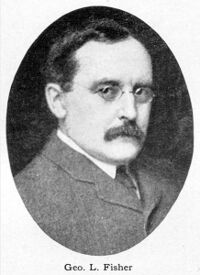Difference between revisions of "George Lee Fisher (1859-1931), Architect"
(→References) |
(→References) |
||
| Line 127: | Line 127: | ||
8. ''Industrial Chicago: The Building Interests'' Vol. 1 (Chicago: Goodspeed Publishing Company, 1891) accessed through University of Illinois Library Website, August 2, 2012, http://libsysdigi.library.uiuc.edu/oca/Books2008-03/industrialchicag/industrialchicag01good/industrialchicag01good.pdf | 8. ''Industrial Chicago: The Building Interests'' Vol. 1 (Chicago: Goodspeed Publishing Company, 1891) accessed through University of Illinois Library Website, August 2, 2012, http://libsysdigi.library.uiuc.edu/oca/Books2008-03/industrialchicag/industrialchicag01good/industrialchicag01good.pdf | ||
| − | |||
| − | |||
==Page Citation== | ==Page Citation== | ||
Revision as of 09:43, 22 September 2016
George Fisher was born in Pontiac, Michigan, ca. 1859. He graduated from the University of Michigan in 1880 with a degree in civil engineering, then moved to Omaha, Nebraska, in 1881 to become the head draftsman for the firm, Dufrene & Mendelssohn. In 1885, Fisher became a partner in the firm, which segued from Mendelssohn, Fisher & Lawrie, to Fisher & Lawrie in 1894. After the demise of the latter firm, in 1913, Fisher practiced architecture alone until his death in 1931, around the age of 72.[1][2] Fisher was a charter member of the Western Association of Architects, 1884, as well as a member of the American Institute of Architects.[7][8:302][d]
This page is a contribution to the publication, Place Makers of Nebraska: The Architects. See the format and contents page for more information on the compilation and page organization.
Contents
Compiled Nebraska Directory Listings
Omaha, Nebraska, 1887, 1920-1931
Educational & Professional Associations
1884: draftsman, Dufrene & Mendelssohn, Architects, Omaha, Nebraska.[a]
1885-1886: architect, Mendelssohn & Lawrie, Architects, Omaha, Nebraska.
1887: architect, Board of Trade Building 1605 Farnam, Omaha, Nebraska.
1888-1892: architect and partner, Mendelssohn, Fisher & Lawrie, Architects, Omaha, Nebraska.
1893-1913: architect and partner, Fisher & Lawrie, Architects, Omaha, Nebraska.
1914-1915: architect, Omaha, Nebraska.
1916-1928: no Omaha directories.
1929-1931: architect, 1439 City National Bank Building, Omaha, Nebraska.
Other Associations
1887: employed William E. Stockham, architect.
1927-1929: employed Claude K. Camblin, designer.[4]
Buildings & Projects
Dated
Cato (1887), 801-03 Park Ave, 2921-23 Leavenworth, Omaha, Nebraska.[6] (DO09:0205-088)
House for Francis & Deer Strs (1887), 2104 S 34th St, Omaha, Nebraska.[3:94][6] (DO09:0200-015)
House for Francis & Deer Strs (1887), 2106 S 34th St, Omaha, Nebraska.[3:94][6] (DO09:0200-016)
House for Francis & Deer Strs (1887), 2108 S 34th St, Omaha, Nebraska.[3:94][6] (DO09:0200-017)
House for Francis & Deer Strs (1887), 2110 S 34th St, Omaha, Nebraska.[3:95][6] (DO09:0200-018)
J. P. Bay/Thomas A Fry House (1887), 2024 Binney, Omaha, Nebraska.[3:105][6] (DO09:0140-007)
House (1887), 2130 Binney, Omaha, Nebraska.[6] (DO09:0140-084)
Trinity Methodist Episcopal Church (1887), 2029 Binney, Omaha, Nebraska.[3:106][6] (DO09:0140-124)
Rowhouse (1887), 714 N. 18th St., Omaha, Nebraska.[6] (DO09:0128-066)
House (1887), 4162 Chicago St., Omaha, Nebraska.[6] (DO09:0322-016)
House (1887), 1907 Wirt St., Omaha, Nebraska.[6] (DO09:0140-096)
LaSalle Apartments (1887, 1924), 3202 Harney St., Omaha, Nebraska.[6] (DO09:0210-012)
House (1888), 1622 Lothrop St., Omaha, Nebraska.[6] (DO09:0142-056)
Thayer Building/J.P.Cooke Building (1889), 1311 Howard St., Omaha, Nebraska. (DO09:0121-013)
Kiesers Bookstore (1895), 1516 Capitol Ave., Omaha, Nebraska.[6] (DO09:0125-011)
J.B. Berry House (1898), 117 S. 39th, Omaha, Nebraska.[5][6][b] (DO09:0319-023)
Commercial Building (1909), 318 S. 19th St., Omaha, Nebraska.[6] (DO09:0124-041)
Kennedy Elementary School (1910), 2906 N. 30th St., Omaha, Nebraska.[1][6] (DO09:0226-002)
Jones Opper/Van Brunt Automobile Company (1918), 2562 Farnam St., Omaha, Nebraska.[6] (DO09:0209-017)
Epstein Brothers Store (1919), 4901 S 24th St, Omaha, Nebraska.[3:61]
Anton Hospe Music Warehouse (1919), 109 S. 10th St., Omaha, Nebraska.[5][6] (DO09:0123-073) NRHP form and photos
Western Motor Car Company (1919)-Sears Roebuck Bldg.(1933), 3002 Farnam St., Omaha, Nebraska.[1][6][c] (DO09:0210-008)
Central Police Station (1920), 101 S.11th St (10th & Dodge), Omaha, Nebraska.[1][6] (DO09:0123-070)
Evangelical Church of Benson/Immanuel Lutheran Church (1920), 2725 N 60th Ave, Omaha, Nebraska.[3:40][6] (DO09:0557-001)
O’Brien-Davis-Coad Auto Co. Building (1920), 2757 Harney St., Omaha, Nebraska.[6] (DO09:0209-046)
Duplex (1924), 1614 Lothrop St., Omaha, Nebraska.[6] (DO09:0142-057)
House (1925), 1626 Lothrop St., Omaha, Nebraska.[6] (DO09:0142-055)
House (1925), 1630 Lothrop St., Omaha, Nebraska.[6] (DO09:0142-054)
House (1929), 2001 N. 55th St., Omaha, Nebraska.[6] (DO09:0444-047)
Undated
Florence Pumping Station (n.d.), original building, Florence, Nebraska.
Y.M.C.A. Building (n.d.), Omaha, Nebraska.[1]
Paxton Block (n.d.), Omaha, Nebraska.[1]
W.O.W. Building (n.d.), Associate Architect [1]
Notes
a. First Omaha directory listing, 1884.
b. Listed in Nebraska Historic Buildings Survey database as Fisher, alone.
c. This was completely remodeled in 2001 as the Twin Towers.[6]
d. Portraits of Fisher are published in Nebraskans, 1854-1904 (Omaha: Bee Publishing Co., 1904) [978.2.B39n], and James B. Haines. History of the Trans-Mississippi and International Exposition of 1898. ([Omaha]: Committee on History, 1910), p. 125.
References
1. Obituary, Omaha World Herald (November 10, 1931).
2. Who's Who in Omaha (1928), 69-70.
3. Landmarks, Inc., An Inventory of Historic Omaha Buildings (Omaha: City of Omaha and Landmarks Heritage Preservation Commission, 1980).
4. Application of Claude K. Camblin for Registration to Practice Professional Engineering and Architecture, Nebraska State Board of Examiners for Professional Engineers and Architects, June 14, 1938. Nebraska State Historical Society, RG081 SG2.
5. Listed in the National Register of Historic Places.
6. City of Omaha Planning Department, Landmarks Heritage Preservation Commission, Database, Query on Architects, May 20, 2002; courtesy of Lynn Meyer, Preservation Planner.
7. AIA Historical Directory of American Architects: A Resource Guide to Finding Information About Past Architects, accessed May 4, 2010, http://communities.aia.org/sites/hdoaa/wiki/Wiki%20Pages/ahd1013879.aspx
8. Industrial Chicago: The Building Interests Vol. 1 (Chicago: Goodspeed Publishing Company, 1891) accessed through University of Illinois Library Website, August 2, 2012, http://libsysdigi.library.uiuc.edu/oca/Books2008-03/industrialchicag/industrialchicag01good/industrialchicag01good.pdf
Page Citation
D. Murphy, “George Lee Fisher (1859-1931), Architect,” in David Murphy, Edward F. Zimmer, and Lynn Meyer, comps. Place Makers of Nebraska: The Architects. Lincoln: Nebraska State Historical Society, May 5, 2015. http://www.e-nebraskahistory.org/index.php?title=Place_Makers_of_Nebraska:_The_Architects Accessed, November 23, 2024.
Contact the Nebraska State Historic Preservation Office with questions or comments concerning this page, including any problems you may have with broken links (see, however, the Disclaimers link at the bottom of this page). Please provide the URL to this page with your inquiry.
